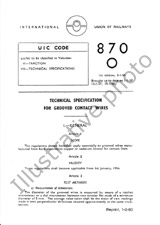We need your consent to use the individual data so that you can see information about your interests, among other things. Click "OK" to give your consent.

UIC 426-3ed.
Standardised seals - Guidelines for sealing wagons and intermodal transport units
Translate name
STANDARD published on 1.7.2017
| Availability | Sold out |
| Price | ON REQUEST excl. VAT |
| ON REQUEST |
The information about the standard:
Designation standards: UIC 426-3ed.
Publication date standards: 1.7.2017
SKU: NS-694023
The number of pages: 21
Approximate weight : 63 g (0.14 lbs)
Country: International technical standard
Annotation of standard text UIC 426-3ed. :
3rd edition, July 2017 - Translation
In a liberalised European rail transport market, ongoing efforts are made to accelerate international freight traffic by eliminating to a large extent checks and formalities at the borders.
For this purpose it is essential that consignments are handled in accordance with rules from the moment they are accepted at the handover site (siding, station, port, container terminal, etc.). This includes ensuring that they can be properly identified, i.e. ensuring as per legal requirements that the goods due to be conveyed are unaltered upon receipt. In this respect seals only ensure that tampering during the journey can be identified.
Proper identifiability is a requirement of customs law (transit procedure, export procedure) which is met by affixing seals (sealing packages, sealing the space containing the goods) or providing a description of the goods in accordance with the relevant requirements. If goods are shipped by rail, railway undertakings (RUs) can ensure compliance with the principle of identifiability under customs law as part of their role as carriers.
The present guidelines define the recognised and standardised seals as the minimum requirement for sealing spaces in which goods are contained for conveyance by rail, and refer to a checklist for affixing seals on wagons and intermodal transport units. The checklist was prepared due to the variety of types and sealing devices.
Standardisierte Verschlüsse - Leitfaden für das Anbringen von Verschlüssen an Güterwagen und intermodalen Transporteinheiten|3. Ausgabe, Juli 2017 - Originalfassung
In einem liberalisierten europäischen Eisenbahnverkehr werden permanent Anstrengungen unternommen, um den grenzüberschreitenden Güterverkehr durch den weitgehenden Verzicht auf Kontrollen und Regularien an den Grenzen zu beschleunigen.
Diese Zielsetzung setzt die ordnungsgemäße Behandlung der Sendungen bereits bei der Übernahme am Übernahmeort (Anschlussgleis, Bahnhof, Hafen, Containerterminal, usw.) voraus. Dazu gehört auch eine ordnungsgemäße Nämlichkeitssicherung, d.h. nach formalrechtlichen Regelungen sicherzustellen, dass die zur Beförderung gelangte Ware unverändert im Empfang ankommt. Hierbei stellen die Verschlüsse nur sicher, dass Unterwegsmanipulationen an ihr erkennbar sind.
Die ordnungsgemäße Nämlichkeitssicherung ist eine Bedingung des Zollrechts (Versandverfahren, Ausfuhrverfahren) und erfolgt durch Verschluss (Packstückverschluss, Raumverschluss) bzw. unter entsprechenden Voraussetzungen durch Warenbeschreibung. Wenn die Waren im Eisenbahnverkehr befördert werden, können die Eisenbahnverkehrsunternehmen (EVU) in ihrer Rolle als Beförderer
zollrechtlich die Einhaltung des Nämlichkeitsprinzips sicherstellen.
Dieser Leitfaden definiert die anerkannten standardisierten Verschlüsse als Mindestanforderung für den Raumverschluss im Eisenbahnverkehr und berücksichtigt außerdem die "Checkliste" für das Anbringen von Verschlüssen an Güterwagen und intermodalen Transporteinheiten. Diese Checkliste wurde wegen der unterschiedlichen Typen und Verschlusseinrichtungen erstellt.
ISBN: : 978-2-7461-2637-4
We recommend:
Technical standards updating
Do you want to make sure you use only the valid technical standards?
We can offer you a solution which will provide you a monthly overview concerning the updating of standards which you use.
Would you like to know more? Look at this page.



 Cookies
Cookies
